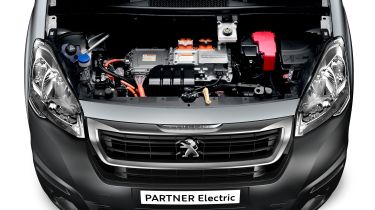Peugeot Partner Electric van (2013-2019) motor, drive & performance
Instant torque ensures the Peugeot Partner Electric is quick off the line, but the rest of the drive isn’t very thrilling

As it has load-carrying in mind, the Peugeot Partner Electric foregoes any kind of driving fun. But that’s also the case with its electric van rivals. With the front-mounted motor driving the front wheels and the batteries located in the back either side of the rear axle, the Peugeot is conventionally laid out, while acceleration off the line is eager, thanks to the 66bhp power output of the electric motor.
The weight of the batteries should help the van’s ride, but stiffer suspension has been added to cope with the extra kilogrammes, so ride quality is about as choppy as it is in the diesel Partner.
Peugeot Partner Electric van motor, 0-62mph and acceleration
The front-mounted electric motor has a quoted power output of 66bhp, which is 6bhp more than the Renault Kangoo Z.E. That gives the Partner a 0-62mph time of 18.7 seconds, which is pretty lethargic, and a top speed of only 68mph.
Really, you won’t be setting any performance times in the Partner, especially because every use of full throttle decimates the expected driving range. The best thing to do is take it easy, and revel in the Partner Electric’s refined road manners at lower speeds. Go any faster than 30mph, and you’ll start to hear more road and tyre noise echoing around the load area. If you want to reduce this, the optional steel bulkhead that goes behind the cabin helps matters.
Handling
With more weight to carry around than a standard Peugeot Partner – the Electric is nearly 300kg heavier than the lightest diesel version – it’s no surprise that the Partner Electric isn’t much fun to drive. It’s based on an older platform that's been used on cars as varied as the 5008 MPV and RCZ coupe, but here it’s been set up with load-carrying as the top priority.
The weight of the batteries keeps the ride in check, although it does contribute to plenty of body lean in corners, even at low speeds. The suspension is on the firm side, but there’s still a fair amount of bounce, even though there’s more weight on board from the batteries. Still, the Partner Electric is at its best in town, where its limited performance isn’t as much of an issue compared to driving one for a longer distance.



